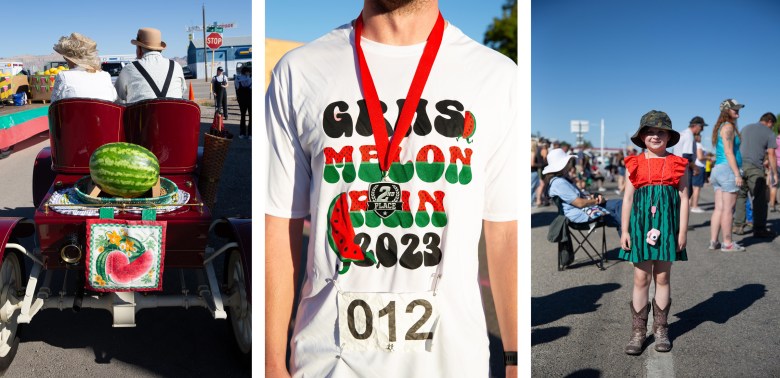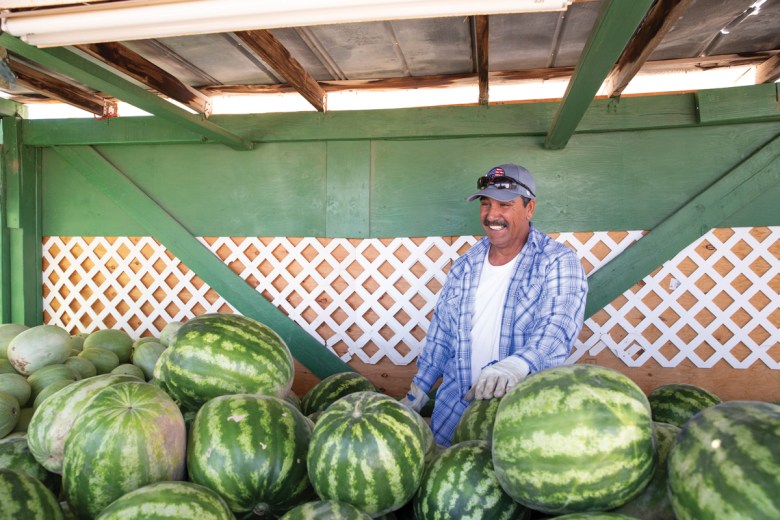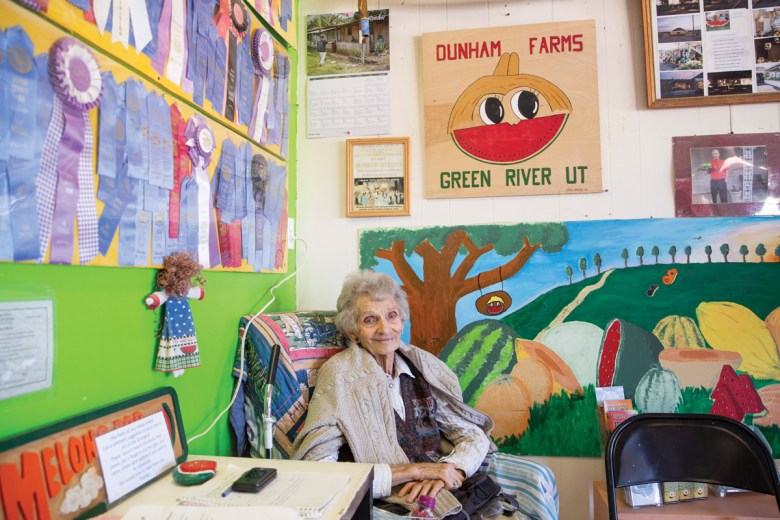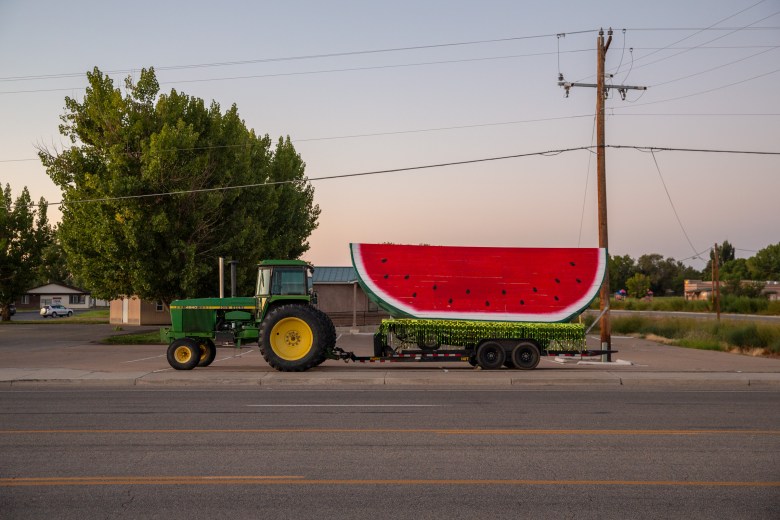During the last weekend of summer, the streets of Green River, Utah were filled with melons. Farmers rapidly chopped slices of peach-colored crenshaws and classic red crimson sweets to hand out in the town’s park. The fruit gave off a sugary, earthy aroma, and friends and family embraced each other with hands sticky from its juice. Pictures of melons dotted everything from bikini tops to bucket hats. A parade led by the town’s major melon-growing families featured a John Deere tractor pulling a 20-foot-long, 10-foot-tall wooden watermelon slice, originally constructed back in 1960.
Melon Days has been celebrated in one form or another here since 1906. It’s the town’s biggest weekend of the year: The population jumps from 800 to 4,000 or 5,000, with this year’s visitors coming from as far away as Alaska and Washington, D.C. Green River’s hot days and cool nights, a product of the town’s high desert climate on the Colorado Plateau, make it an ideal spot for melons, as does the river flowing through the center of town.
“Melons are just a happy food,” Nancy Dunham, the 92-year-old matriarch of Dunham Melons, said during an interview at the family’s permanent stand on Main Street. Sitting in front of a wall covered with first-place ribbons from state and county fairs, she pointed to the farm’s logo — a face with a watermelon slice as the smile. Nancy, who studied agriculture at Colorado State University, drives around with a bumper sticker that says “All Soil Is Sacred.” She still tries to walk barefoot every day in the grass at the family farm, which her son Chris and his wife, Olive, now run.

“Melons are just a happy food.”
The Dunham family came to Green River in the 1950s, seeking a base for their uranium-mining supply company. Green River was in the midst of a uranium mining boom and was home to a mill that’s now a tailings disposal site. The area also served as a missile test site; the theme of the 1964 Melon Days was “From Melons to Missiles.” A giant full-scale model of an Athena missile still dominates the town’s park.

The Dunhams began growing melons and pumpkins soon after their arrival; in the 1960s, the kids sold produce from a Red Flyer wagon next to the highway. Then, in the 1970s, the uranium industry collapsed, and farming became the family’s primary business. Today, Chris Dunham’s oldest son, Matthew, travels an hour from Moab on weekends to help during the summer. Gabriel, the younger son, currently studies mechanics in a trade school program, but he came home for Melon Days. Tossing and slicing melons in the park, he said he hopes to keep the family farm going.
While Chris Dunham oversees the farm, much of the day-to-day work is done by foreman Abel Herrera, who has worked for the Dunhams since 1991. He coordinates the farmworkers and works with Chris to manage the planting, cultivating, harvesting and soil health. Chris, who shares his mother’s love of the soil, has been cutting back the farm’s use of pesticides and nonorganic fertilizers. The farm grows alfalfa and fall crops like squash and pumpkin, rotate cover crops in the winter to improve the soil and manage a herd of cattle. Herrera learned how to care for livestock while working on a ranch in Mexico as a kid. “I’ve been working on a ranch my whole life,” he said.

Herrera and his family live in Green River. He enjoys the quiet of the small town, he said, but most of his days are spent at work. At the festival, restocking heavy melons to keep up with all the purchases, Herrera said that he and his crew work long days every day during melon season. “This is hard work,” he told High Country News during a phone interview after Melon Days. Most labor is still done by hand, including time-intensive weeding between the melons’ delicate sprawling vines.
Extreme heat is making working conditions challenging for the farmworkers, who labor in 110-degree temperatures at the peak of summer, Herrera said. “Working under the sun is the worst,” he said. According to recent census data, 33% of Green River’s residents identify as Latino or Hispanic, and immigrant farmworkers on H-2A visas provide labor for some of the melon farms. Herrera himself is a naturalized citizen who immigrated to the U.S. from Mexico.

These days, the possibility of another bust looms over the melon festival. The extreme heat impacting workers also threatens soil and plant health, and drought across the Colorado River Basin — including the Green River — could affect farmers’ access to water. The consolidation of small family grocery stores into a few big corporations has also hit some farming families hard. Tim Vetere, whose grandfather started growing melons in Green River over a century ago, said the Veteres used to sell to Macey’s, a historically family-owned grocery store in Utah. After Associated Food Stores bought the local chain, melon sales dropped, and Vetere believes his family will have to eventually give up their farm.
The extreme heat impacting workers also threatens soil and plant health, and drought across the Colorado River Basin could affect farmers’ access to water.
The Dunhams work with some distributors but prefer to sell most of their melons directly to consumers, either at their stand in Green River or at farmers markets across the Southwest, as well as to “peddlers” who sell Dunham melons out of their own cars or stands.
Over time, melon farmers have come and gone: Memories & Melons, a Green River history book, documents more than two dozen melon-growing families, including three current growers, dating back to the late 1800s. But throughout these shifts in farm ownership, Green River’s melons have remained.

Brooke Larsen is the Virginia Spencer Davis Fellow for HCN, covering rural communities, agriculture and conservation. She reports from Salt Lake City, Utah. Email her at brooke.larsen@hcn.org or submit a letter to the editor. See our letters to the editor policy. Follow her on Instagram @jbrookelarsen or Twitter @JBrookeLarsen.
This article appeared in the print edition of the magazine with the headline Melon days.


